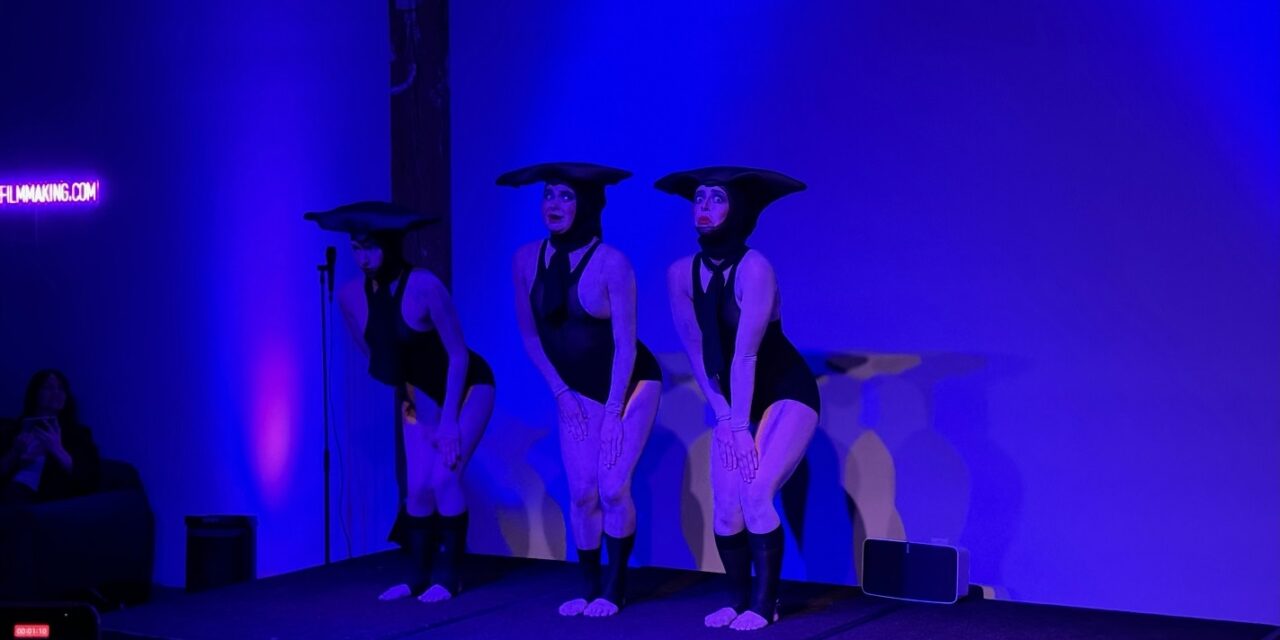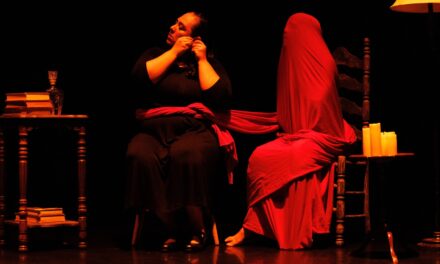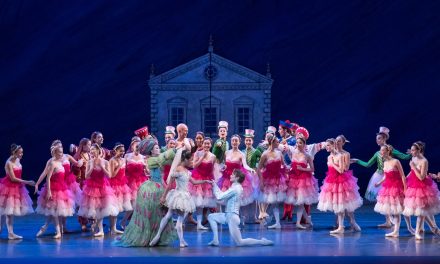Dance Filmmaking presented its inaugural Dance Film of the Year Award Show and After Party on April 6, 2024. The team wanted to share something with L.A. that wasn’t just another film festival, but rather a celebration of innovations in dance. Entering spaCe DTLA where the event was held, that approach was very clear.
The first half of the night was more casual. People could chat, grab a drink, and view the finalists for the organization’s award. The top films — A Myriad Mind by Marie Zechiel, Bubblegum by Ryan Renshaw, Don’t Cry Maggie by Denna Thomsen and Nina McNeely, They Saw The Sun First by Stefan Hunt, and Uholdeak by Olatz Larunbe and Bárbara Fdez — were screened simultaneously on medium-sized box TVs with headphones attached. One by one, people could walk up and view each film.
Leading up to the live performances, I sat for Renshaw’s piece. It was a gritty solo that followed a man dancing in the street and stumbling his way home. Although I did not see all of them, I knew they were all available on Dance Filmmaking’s website.
Standing in the main space of the event with a friend, a performer wearing a black triangular headpiece and tights snuck up from behind us, mimicking my friend’s body language and clapping hands. At first jarring, I burst into laughter once I realized what happened. I turned around and saw multiple performers dressed the same sneaking into conversations. It was a successful comedic teaser for what was ahead.
The live performance brought everyone’s attention to a small T-shaped stage against the back wall. The lineup included five acts, but each person’s presentation flowed seamlessly into the next. Charles “Lil Buck” Riley entered the performance space from the crowd, initiating the waves of dance artists that would follow. Lil Buck is known for creating work that is cemented in the Memphis Jookin style. His movement was completely fluid, allowing a single stretch from the arm to inform where the rest of the body went. Often, it felt like he was discovering the flow with us. The slow-moving waves of his upper body were counterbalanced by quick, syncopated footwork. Lil Buck landed on a final pose, twisting his limbs into a knot, and the next round of dancers were already on their way.
Veroman ‘Rome’ Woods and Jon ‘Spirit’ Swapshire of the Los Angeles ballroom scene shared a duet. They were dressed similarly to puppets, mimicking each other while also finding moments to collide and indulge in connection. The highlight of their performance was the duo’s ability to navigate each other, ducking below the other’s arms to initiate a new texture to their relationship. The two found themselves struggling to find a sense of relief from an invisible tension pulling them both away from each other and into each other, but eventually, there was a final calming embrace.
Marcella Lewis and Qwenga followed up with a performance that covered even more physical ground, moving from the stage to the margins in front of the audience. Qwenga is known for folding elaborate narratives into his movement practice — recently exploring a sci-fi world as part of Infinite Rehearsal at the Institute of Contemporary Art, Los Angeles. Along with Lewis, he told the story of a couple discovering what they mean to each other. The two leaned against their bodies, moving slowly across the stage, but they soon broke apart. One at a time, they pulled away for a pseudo solo. Qwenga started krumping, directing his attention to both the audience and Lewis as he created distance from her. When Lewis broke away from the mold they created with each other, she took a more contemporary-based approach to tell her side of the story. The piece ended on a moving tableau where Lewis remained planted on the floor with a blindfold on while holding Qwenga’s hand as he ran in place, trying to escape her grasp.
The audience’s attention turned to the right where a large, square hole high up on the wall framed the next performer: Gabriel Salazar. His movement crashed into the edges of the frame and simmered into a personal exploration, tutting and grooving at the center of the square to create a moving painting that did not stop. It was mesmerizing and calming to watch — a palate cleanser before the eccentric choreography of Nina McNeely.
The same performers who comedically terrorized the audience before — Olivia Batlle, Iyana Money, and Marina Herlop — took the stage. The trio stayed in a tight-knit huddle, dancing on similar levels but interpreting the choreography in their unique view. The movement language was quirky and awkward, consisting of expressive faces and quick stretches of the arms. The performers were specific with their choices, especially when they sought to connect with an audience member by snapping their hand or focusing their gaze on a specific person.
The lineup was a well-rounded look at the dance communities in Los Angeles, putting entertainment choreographers in conversation with experimental live creators. The team concluded the ceremony by awarding the winning film: They Saw The Sun First.
They Saw The Sun First reflects on aging, putting movement to personal accounts of life today from the perspective of elders. Their responses share the realities younger generations face. The dancing is often lyrical, connecting to what is being said. One elder asks, “Wouldn’t you like to go to the moon?” as a spaceship launches with a dancer sitting on the wing from space. Performers bring the reflections to life for a melancholic reality check that this time of growing technology, environmental changes, and a new set of fears can be difficult. But somehow, this generation finds ways to dance through it all.
The film was an emotionally packed button for the night, reminding the audience of the joys of dance. The film, along with the joyous and energized live performances, brought attention to the importance of valuing every moment of life, whether you are reading this review or heading out the door to the next dance show.
For more information about Dance Filmmaking, please visit their website.
This article was edited to correct names on 4/11/24
Written by Steven Vargas for LA Dance Chronicle.
Featured photo: Olivia Batlle, Iyana Money, and Marina Herlop in work by Nina McNeely – Photo by Matt Spicer.













